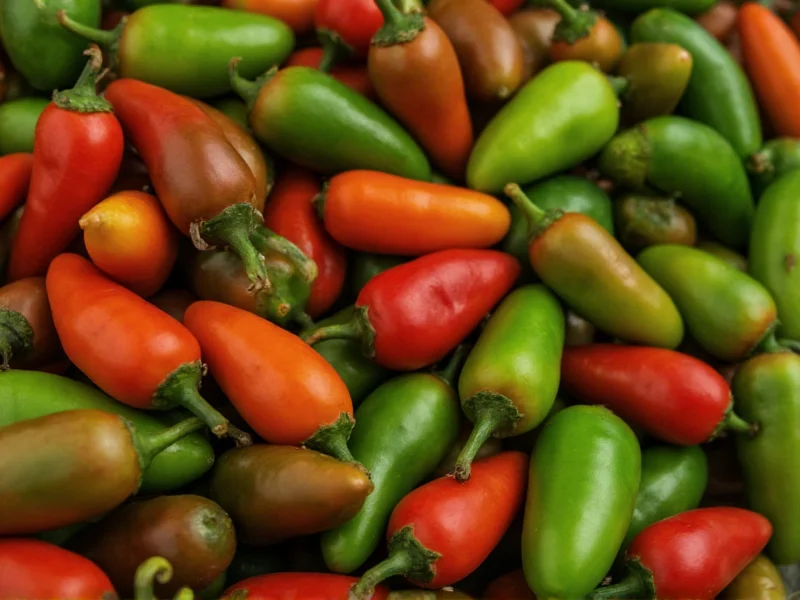The Scoville scale, developed by pharmacist Wilbur Scoville in 1912, measures the pungency or "heat" of chili peppers and other spicy foods. Originally determined through human taste testing, modern measurements use high-performance liquid chromatography (HPLC) for precise capsaicin concentration analysis. Understanding where jalapeños fall on this scale helps cooks and spice enthusiasts make informed decisions about their culinary applications.
Understanding Jalapeño Heat Variability
Jalapeños exhibit remarkable heat variation despite their classification within a specific Scoville range. Several factors influence their actual heat level:
- Growing conditions: Soil quality, water stress, and sunlight exposure significantly impact capsaicin production. Peppers grown in stressful conditions often develop higher heat levels.
- Ripeness: Green jalapeños tend to be milder than their red, fully ripe counterparts, which can reach the upper end of the Scoville range.
- Seed and membrane content: The white pith and seeds contain most of the capsaicin. Removing these reduces perceived heat substantially.
- Cultivar differences: Specific jalapeño varieties like 'Early Jalapeño' or 'Jalapeño M' have different heat profiles.
Comparing Jalapeños to Other Common Peppers
Understanding jalapeño scoville units becomes clearer when viewed alongside other popular peppers. The table below shows where jalapeños fit within the broader pepper heat spectrum:
| Pepper Type | Scoville Heat Units (SHU) | Heat Level Comparison |
|---|---|---|
| Bell Pepper | 0 SHU | 0 times jalapeño heat |
| Poblano | 1,000-2,000 SHU | 0.25-0.5x jalapeño heat |
| Jalapeño | 2,500-8,000 SHU | Baseline |
| Serrano | 10,000-23,000 SHU | 2-4x jalapeño heat |
| Habanero | 100,000-350,000 SHU | 15-40x jalapeño heat |
| Ghost Pepper | 855,000-1,041,427 SHU | 100-130x jalapeño heat |
Practical Applications of Jalapeño Heat Knowledge
Knowing the jalapeno scoville heat units range has direct culinary implications. Chefs and home cooks can leverage this information to create balanced dishes that deliver the desired heat experience without overwhelming other flavors.
When working with jalapeños, consider these practical tips:
- Taste before using: Sample a small piece to gauge the actual heat level of your specific batch.
- Control heat exposure: Wear gloves when handling, especially when removing seeds and membranes where capsaicin concentration is highest.
- Heat reduction techniques: Soaking sliced jalapeños in salt water or milk can reduce perceived heat while maintaining flavor.
- Heat enhancement: Roasting jalapeños can intensify their heat profile while adding smoky complexity.
- Storage considerations: Fresh jalapeños maintain consistent heat for 1-2 weeks refrigerated, but heat diminishes over time.
Common Misconceptions About Jalapeño Heat
Several myths persist about jalapeño heat levels that deserve clarification. Many believe that smaller jalapeños are always hotter, but size correlates weakly with actual heat. The presence of white striations (corking) on the pepper's skin often indicates higher stress during growth, which can increase heat, but this isn't a perfect predictor.
Another common misunderstanding involves the relationship between color and heat. While red jalapeños are typically hotter than green ones, this isn't universally true. The ripening process increases sugar content along with capsaicin, creating a different flavor profile rather than simply becoming "hotter."
Measuring Heat in Your Kitchen
Without laboratory equipment, determining the exact scoville level of your jalapeños requires practical assessment. The "milk test" offers a surprisingly effective method: consume a small piece of pepper followed by a sip of whole milk. The time it takes for the burning sensation to subside provides a relative measure of heat intensity.
For recipe development, consider creating a personal heat scale based on your tolerance. Rate jalapeños from 1-5 based on your sensory experience, noting factors like growing source and preparation method. This personalized approach often proves more useful than theoretical Scoville numbers when planning dishes for specific audiences.











 浙公网安备
33010002000092号
浙公网安备
33010002000092号 浙B2-20120091-4
浙B2-20120091-4